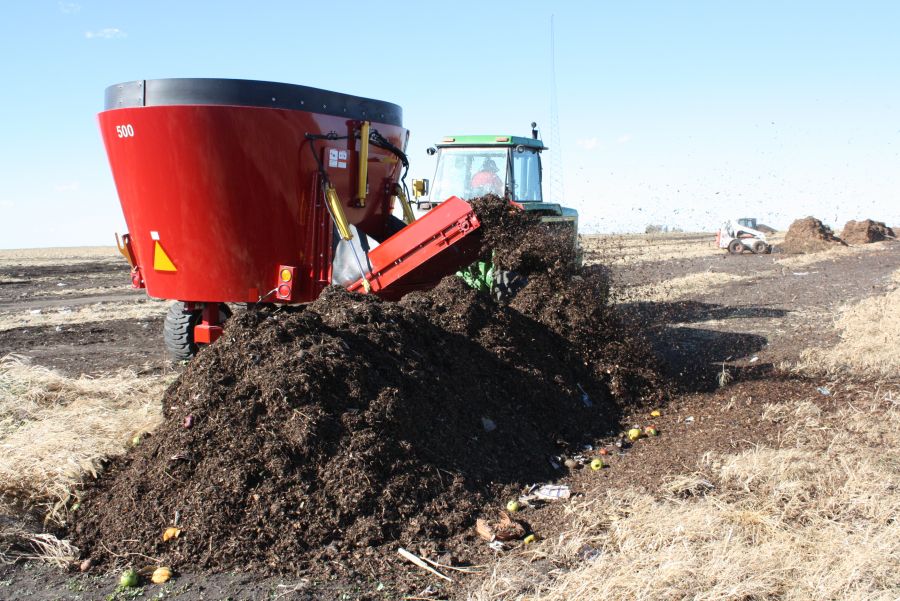The McLean County landfill is expected to reach capacity in 2017. When that happens, Illinois State University–and a lot of other institutions, businesses, and private citizens–will face the prospect of sending trash to landfills in other parts of the state. In addition to the environmental impact, that may prove to be very expensive.
The prospect of a larger waste-hauling bill is adding an extra sense of urgency to the University’s landfill diversion and recycling efforts. It is also influencing long-term decisions about resource use and purchasing practices.
Cost analysis studies on shipping waste from campus to landfills outside McLean County are being conducted this fall by Illinois State student researchers. The results of those studies will support future landfill diversion initiatives. “This is a great opportunity for students to put their research skills to work on an urgent University issue,” said Sustainability Coordinator Missy Nergard. “That kind of analysis can also show the financial benefits of keeping more material out of the landfill.”
Illinois State has had a robust recycling program for decades, and efforts to keep food waste from the landfill through composting have proved very successful. Programs have also been implemented to recycle a wide variety of items from books, to electronics, to building materials. However, there is always more to be accomplished.
“We’ve done a great deal on the operational level to divert things from the landfill,” said Nergard. “What’ll really make these efforts work is getting even greater buy-in from the campus community.”
Nergard and Recycling Coordinator Andrew Bennett both note that students arriving on campus as freshmen come with the expectation that recycling and other sustainability practices are already part of the campus culture. They say student awareness and enthusiasm helps to drive the University’s waste reduction and recycling efforts. “That buy-in is important for bringing about behavioral changes,” said Nergard.
Bennett hopes that a seemingly simple change of words on waste containers could give people something more to think about as they are throwing things away. “We’re discussing the idea of labeling waste containers with the word ‘landfill’ instead of ‘waste,’” he said. “That would tell people very clearly where that material is going. That could make people think more about what they’re putting in those containers.”
Numbers tell a powerful story about the items that are kept out of the landfill each year. During fiscal year 2014, Illinois State recycled–among other things–216 tons of cardboard, 60 tons of office paper, 107 tons of scrap metal, 23 tons of asphalt, 32 tons of concrete, 9 tons of electronics, and 29 tons of books. Single-stream recycling–mixed items like plastic, aluminum, and glass–weighed in at 199 tons. Around 300 tons of food scraps from dining centers were composted rather than buried.
In recent years, the composting operation expanded to accept food scraps from other community businesses and schools. Nergard said the University is also exploring other avenues for diverting food before it is even classified as waste.
“We’re looking at more food-recovery options,” she said. “Ways that we can get items such as baked goods and canned goods to local agencies and food pantries so they aren’t wasted. Some food items can also be used as animal feed instead of going straight to compost.”
The vision of waste minimization is being applied in all aspects of campus operations. The University works with local agencies to collect usable furniture, clothing, and electronics from students during move-out times. Administrative Technologies rebuilds computers for use on campus through an e-refurbishment program. “All types of batteries and electronic devices are collected for recycling, as a wide variety of electronic devices, along with automotive batteries, are banned from Illinois landfills,” said Bennett. “We’re working with contractors on ways to recycle building materials such as scrap metal, shingles, and asphalt. Through a pilot program, launched this summer, we’re exploring options for recycling Styrofoam.”
Throwing away less can have the added long-term benefit of making people’s jobs a bit more efficient. “Building service workers and grounds workers would be able to concentrate more on other parts of their jobs, and spend less time collecting and handling trash,” said Nergard.
In the meantime, technology is helping to make trash collection a little more efficient. Eight solar trash compactors are operating around campus. “The compactors notify us electronically when they’re full, so that cuts down on the labor a bit,” Nergard noted. “But, it’s ultimately about more than better trash disposal and recycling. It’s about examining the whole process and taking into consideration what we buy, how we use it, and what we can do with it when we’re finished. That’s a cultural shift, and we’re certainly moving in that direction.”


